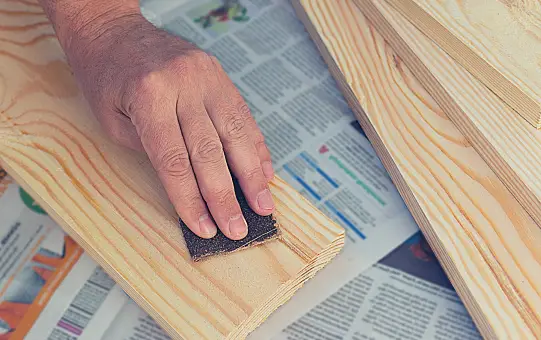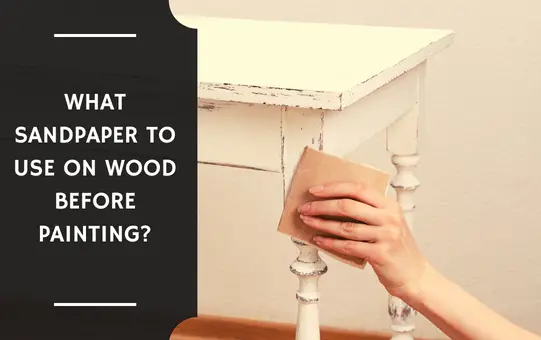When it comes to painting wood surfaces, proper preparation is key to achieving a smooth and professional finish.
One essential step in the preparation process is sanding the wood to create a clean and smooth surface for the paint to adhere to.
What Sandpaper to Use on Wood Before Painting?
Sandpaper is a good option for wood before painting because it will give the wood a rough surface that will be easier to paint on.
In this article, we will explore the different sandpapers and guide you on what sandpaper to use on wood before painting.
See Also: What Sandpaper to Use on Headlights?
What Sandpaper to Use on Wood Before Painting? – Guide
Choosing the right sandpaper for the job can be confusing, as there are various grits and types available. This detailed guide will tell about the perfect sandpaper for wood before painting:
Understanding Grits
Coarse to Fine The grit of sandpaper refers to the size of the abrasive particles on its surface. Sandpapers are available in a range of grits, starting from coarse to fine.
Coarse grits have larger particles and are suitable for heavy sanding and removing rough surfaces or old paint.
Fine grits have smaller particles and are used for smoothing surfaces and preparing them for paint.
When selecting sandpaper, consider the condition of the wood surface and the amount of sanding required.
Coarse Grits (40-60)
Initial Sanding For initial sanding or removing rough surfaces, start with coarse-grit sandpaper, typically in the range of 40 to 60.
This grit is ideal for tackling imperfections such as bumps, unevenness, or previous paint layers.
It quickly strips away the old paint and roughens the surface, providing a good base for further sanding. Remember to sand in the direction of the wood grain to avoid scratches.

Medium Grits (80-120)
Smoothing the Surface After the initial sanding, transition to a medium-grit sandpaper, which usually falls within the range of 80 to 120.
Medium-grit sandpaper is effective at smoothing out the wood surface, removing scratches left by the coarse grit, and creating a uniform texture.
It helps to level the surface and prepares it for finer sanding and painting. As before, sand along the grain for the best results.
Fine Grits (150-220)
Preparing for Paint As you progress towards the final stages of sanding, switch to fine-grit sandpaper, typically between 150 and 220.
Fine-grit sandpaper is used to refine the surface further, removing any remaining imperfections, scratches, or roughness. It creates a smooth and even texture, ensuring that the paint adheres evenly.
This step is crucial for achieving a professional-looking finish. Lightly sand the surface, again following the direction of the wood grain.
Extra-Fine Grits (320 and Above)
Between Coats and Final Touches In certain cases, when an exceptionally smooth surface is desired, you may opt for extra-fine grit sandpaper.
These sandpapers have grits starting from 320 and above. Extra-fine grit sandpaper is typically used between coats of paint to remove any dust particles or small imperfections that may have appeared during the painting process.
It also helps to create a smoother finish on the final coat. However, it’s important to note that using extra-fine grit sandpaper may not be necessary for all painting projects.
In addition to the grit, you should also consider the type of sandpaper. There are three common types: garnet, aluminum oxide, and silicon carbide.
Garnet sandpaper is suitable for light sanding and is often used for fine woodworking. Aluminum oxide sandpaper is versatile and can be used for both wood and metal surfaces.
Silicon carbide sandpaper is highly durable and is often used for sanding harder materials like glass or stone. For most wood painting projects, aluminum oxide sandpaper is a good choice due to its versatility.
What Grit Sandpaper to Scuff Paint to Repaint?
It depends on the type of paint you are using. For most paints, a 120-grit sandpaper is usually a good starting point for scuffing the surface.
However, you may need to use finer grit sandpaper if you are using harder paint, such as epoxy paint.
what grit sandpaper for wood before painting?
What sandpaper to use before painting? Before painting wood, it is generally recommended to use a medium to fine grit sandpaper, such as 120 or 150.
This helps to create a smooth and even surface for the paint to adhere to, ensuring better adhesion and a more professional finish.
What sandpaper to use for wood?
For wood sanding, the choice of sandpaper grit depends on the task. Coarse grits (40-60) are suitable for heavy material removal or shaping.
Medium grits (80-120) work well for general sanding and smoothing rough surfaces. Fine grits (150-220) are ideal for finish sanding and achieving a smooth surface before staining or finishing.
Extra-fine grits (240 and above) are used for final polishing and fine detailing. Select the appropriate grit based on your woodwork project’s requirements, and remember to progress gradually from coarse to fine grits for the best results.
Conclusion
What grit sandpaper before painting wood? No matter which sandpaper use on wood before painting, it is essential to understand the different types and their uses to ensure the best results.
Sandpaper is a great tool to help you achieve a professional, smooth finish on your wood surfaces, so make sure to choose the right one for the job!
I hope this blog post is helpful for you in understanding What Sandpaper to Use on Wood Before Painting.
See Also: Can I Use Sandpaper on My Feet?
